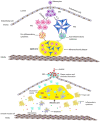Targeting Macrophage Phenotypes and Metabolism as Novel Therapeutic Approaches in Atherosclerosis and Related Cardiovascular Diseases
- PMID: 39133247
- PMCID: PMC11392985
- DOI: 10.1007/s11883-024-01229-z
Targeting Macrophage Phenotypes and Metabolism as Novel Therapeutic Approaches in Atherosclerosis and Related Cardiovascular Diseases
Abstract
Purpose of the review: Macrophage accumulation and activation function as hallmarks of atherosclerosis and have complex and intricate dynamics throughout all components and stages of atherosclerotic plaques. In this review, we focus on the regulatory roles and underlying mechanisms of macrophage phenotypes and metabolism in atherosclerosis. We highlight the diverse range of macrophage phenotypes present in atherosclerosis and their potential roles in progression and regression of atherosclerotic plaque. Furthermore, we discuss the challenges and opportunities in developing therapeutic strategies for preventing and treating atherosclerotic cardiovascular disease.
Recent findings: Dysregulation of macrophage polarization between the proinflammatory M1 and anti-inflammatory M2 phenotypealters the immuno-inflammatory response during atherosclerosis progression, leading to plaque initiation, growth, and ultimately rupture. Altered metabolism of macrophage is a key feature for their function and the subsequent progression of atherosclerotic cardiovascular disease. The immunometabolism of macrophage has been implicated to macrophage activation and metabolic rewiring of macrophages within atherosclerotic lesions, thereby shifting altered macrophage immune-effector and tissue-reparative function. Targeting macrophage phenotypes and metabolism are potential therapeutic strategies in the prevention and treatment of atherosclerosis and atherosclerotic cardiovascular diseases. Understanding the precise function and metabolism of specific macrophage subsets and their contributions to the composition and growth of atherosclerotic plaques could reveal novel strategies to delay or halt development of atherosclerotic cardiovascular diseases and their associated pathophysiological consequences. Identifying biological stimuli capable of modulating macrophage phenotypes and metabolism may lead to the development of innovative therapeutic approaches for treating patients with atherosclerosis and coronary artery diseases.
Keywords: Atherosclerosis; Coronary artery diseases; Macrophage; Metabolism; Phenotype.
© 2024. The Author(s).
Conflict of interest statement
The authors declare no competing interests.
Figures


References
Publication types
MeSH terms
Grants and funding
LinkOut - more resources
Full Text Sources
Medical
Research Materials

